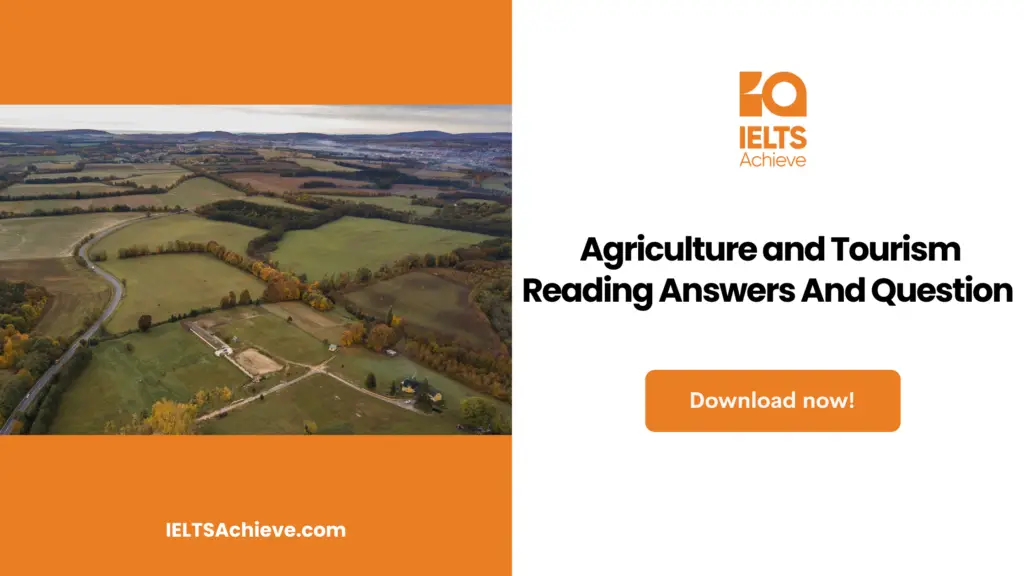The Blog post contains the following IELTS Reading Questions:
- IELTS Reading Sentence Completion
- IELTS Reading True/False/Not given
Stay informed and prepared for success – Explore our comprehensive Reading Test Info page to get valuable insights, exam format details, and expert tips for mastering the IELTS Reading section.
IELTS Reading Passage – Crop Growing Skyscrapers

Crop Growing Skyscrapers
By the end of 2050, almost 80% of the Earth’s population will migrate to urban centres. By making use of the conservative estimates in the present demographic trends, the human population density will increase exponentially up to three billion. Around 120 hectares of new land (about 20% larger than Australia) will be estimated to cultivate enough food to feed them if traditional farming practices continue as they are evolved today. Now, across the world, nearly 80% of the landscape suitable for raising crops is in use. When we go back to the past, some 15% of that has been laid waste due to poor management skills. How to ensure enough food security for the world’s population to live on?
The technique of indoor farming is not new since many hothouse production of tomatoes, onions and other vegetables has been in fashion for a certain time. However, there is an urgent need to increase this technology to feed another three billion human population. Experts believe a whole new concept of indoor farming is required with super-efficient technologies. ‘Vertical Farm’ is one amongst them. The idea is to have multi-storey buildings where food crops are grown in eco-friendly conditions. If they deploy it in the heart of urban centres, they would substantially decrease the transportation cost paid to bring food to the end consumers. This vertical farm has to be effective, accessible to the consumers to operate. Let’s assume it is successfully implemented, proponents claim, vertical farms will guarantee urban renewal, sustainable development production of a safe and varied food chain (round the year production of all crops), and the obvious reconstruction of ecosystems that got deteriorated due to horizontal farming.
The like-minded people of vertical farming discover various benefits of this system. For example, crops can be harvested throughout the year, as they would be preserved in man-made controlled, maximum growing conditions. Similarly, no climate-related crop failures occur due to droughts, floods or pests. All the crops and food could be produced organically, neglecting the inorganic products of herbicides, pesticides and fertilisers. The system would significantly decrease the occurrence of many non-communicable diseases necessary at the agricultural production interface. Even though the system would require energy, it would give it back in a different way to the grid via methane gas generation from composting non-edible parts of plants. This practice will help in reducing the need for tractors, ploughs and shipping, which in turn, reduce in consumption of fossil fuel.
Besides the advantages, a major setback of vertical farming is that the plants need artificial light unlike the traditional farming. However, when those plants are kept near the window, they will be exposed to more sunlight and grow more quickly, reducing the efficiency. Whereas the single-storey greenhouse has the benefit of natural light on the top. Nevertheless, many plants still need artificial lighting other than the natural sunlight.
A multi-storey facility without any natural light at the top might need far more. Producing sufficient light might be expensive, unless cheap, renewable energy is there to support, and this seems to be rather a long-term goal than a tangible result for the near future.
One difference on vertical farming that has been produced is to plant small trees in stacked trays that are alongside rails. Shifting the trays allows the small trees to get good sunlight for photosynthesis. This system is put in place, thus, performs well within a single-storey greenhouse with sufficient sunlight: it is not absolute, but, it is possible to make it work without the sunlight from the above.
Vertical farming is nothing but an attempt to combat the prolonged issues that we face in making food supply for an ever growing human population. Presently, though, more steps need to be taken to decrease the aftermaths happening on the environment, specifically the consumption of energy. While it is doable that our food supply will be produced in skyscrapers in future, experts think that it is way too far that we will merely make use of the space situated on urban area rooftops.
Unlock your full potential in the IELTS Reading section – Visit our IELTS Reading Practice Question Answer page now!
Recommended Questions:
Renewable Energy IELTS Reading Question with Answer
Crop Growing Skyscrapers IELTS Reading Questions
Questions 1 – 7
Complete the sentences below.
Choose NO MORE THAN TWO WORDS from the passage for every answer
Indoor Farming
- There are certain vegetables, including tomatoes _________ that are produced indoors.
- Vertical farms have a major setback, that is __________ .
- There is an urgent need for vertical farming to feed ___________ human population.
- Nearly 120 hectares of land (20% larger than _________) is required for food production in the upcoming years.
- The system consumes energy and returns it back through __________ generation.
- ______________ deteriorated the ecosystem and more consumption of fossil fuels.
- If _____________ buildings are deployed in the heart of urban centres, the food transportation cost would be substantially decreased.
Enhance your sentence completion skills in the IELTS Reading section. Click here to access our comprehensive guide and learn effective strategies for filling in missing words or phrases in sentences.
Questions 8 – 13
Do the following statements agree with the information given in the reading passage?
In boxes 8 – 13 on your answer sheet, write
TRUE if the statement agrees with the information
FALSE if the statement contradicts the information
NOT GIVEN if there is no information on this
8. The concept of indoor farming is not new to humans.
9. By 2050, nearly 80% of the human population will live in urban centres.
10. Vertical farming cannot be preserved by humans due to the usage of tractors, ploughs, etc.
11. Vertical farming won’t be affected by droughts, floods or pests.
12. By making use of the conservative estimates in the current demographic trends, the human population will increase up to two billion.
13. The major setback for vertical farming is it spreads non-communicable diseases.
Enhance your skills in identifying information as True, False, or Not Given. Click here to discover expert strategies and techniques for mastering this question type in the IELTS Reading section.
Unlock your full potential in the IELTS Reading section – Visit our IELTS Reading Practice Question Answer page now!
Recommended Questions:
Renewable Energy IELTS Reading Question with Answer
Crop Growing Skyscrapers IELTS Reading
1. Answer: Onions
2. Answer: Artificial lighting
3. Answer: Three billion
4. Answer: Australia
5. Answer: Methane gas
6. Answer: Horizontal Farming
7. Answer: Multi-storey
8. Answer: True
9. Answer: True
10. Answer: False
11. Answer: True
12. Answer: False
13. Answer: False

We hope you found this post useful in helping you to study for the IELTS Test. If you have any questions please let us know in the comments below or on the Facebook page.
The best way to keep up to date with posts like this is to like us on Facebook, then follow us on Instagram and Pinterest. If you need help preparing for the IELTS Test, join the IELTS Achieve Academy and see how we can assist you to achieve your desired band score. We offer an essay correction service, mock exams and online courses.


